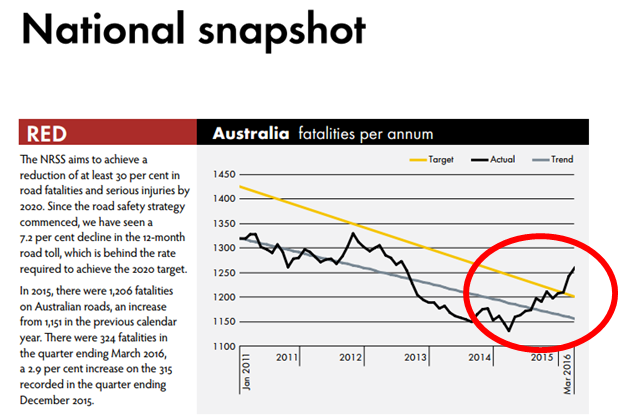Australasian College of Road Safety president, Mr Lauchlan McIntosh AM, said today that the Australian community deserves substantial pre-election road safety policies, particularly in light of the increasing numbers of people dying and being seriously injured on Australian roads.
“Recently the Australian community has been experiencing a disturbing upward trend in road trauma for both deaths and serious injuries (Australian Automobile Association, 2016). Despite the efforts of many road safety stakeholders, Federal government figures show that during the 12 months ended May 2016 there were 1,275 road deaths. This is a 9.8 per cent increase compared to the prior 12 months (BITRE). This has occurred when we have a National Strategy and Action Plan to reduce deaths and injuries from crashes by 30% over the decade (Australian Transport Council, 2011).

(Australian Automobile Association, 2016)
“This increase in road trauma translates to many more daughters, sons, sisters, brothers, mothers, fathers, grandparents and extended families who are facing unnecessary devastation through road trauma. This is compounded by the damage to our communities and workplaces that are left to deal with the fallout of the social costs of well over 33,000 deaths and serious injuries each year”.
“We shouldn’t forget that this road trauma also places a preventable yet increasing burden on our economy. In 2011, Federal government estimates put the annual cost of road trauma to the economy at $27b – more than the size of the Defence Budget. We need to see policies to reduce this major burden, with support for the many stakeholder groups already working so hard to reduce the trauma. The additional costs of the recent increase will be felt across the economy.”
“We have seen a marked increase in collaborative actions between stakeholders over the last several years, particularly through Australia’s support for road trauma reductions incorporated into the recent United Nations Sustainable Development Goals, an emphasis on rigorous evidence-based programs, creation of award programs recognising road safety excellence, and unprecedented support for events such as the Australasian Road Safety Conference. We now need all parties in the Australian government to support this revival in enthusiasm and provide the leadership we so desperately need to underpin our collective efforts.”
“Instead of seeing ad hoc reactive handouts coming every time there’s an election, each political party needs to have a solid policy showing leadership in the road safety space – with a program to reduce crashes, support safer roads, safer vehicles and safer drivers, and importantly to provide collaborative leadership to ensure we have scale and not duplication in our programs. Smart, innovative programs and technologies, as well as consistent funding is necessary.” he said.
“At the last federal election we saw policies from all major parties, but they have been absent to date. With so many families and workers continuing to deal with the fall-out from road trauma, the Australian community deserves to see comprehensive policies from all parties, to rapidly put Australia back into world class road safety performance”.